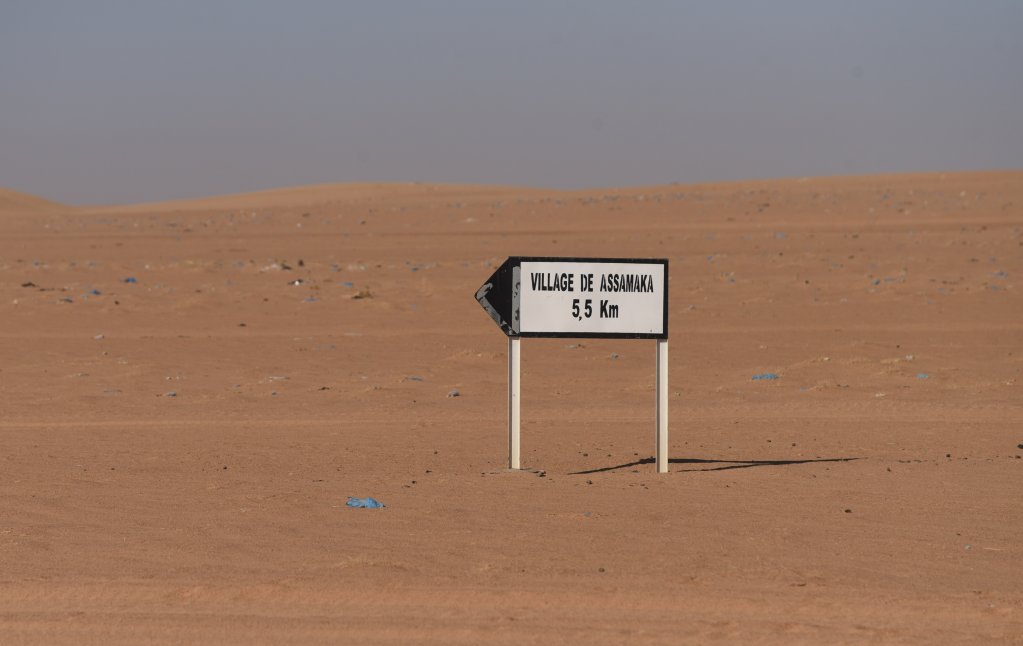In two months, 11 migrants died of thirst in the Algerian desert, near the Niger border, in the so-called "Zero Point" zone, according to Alarm Phone Sahara. Expulsions of sub-Saharan migrants by the Algerian authorities continue at a sustained pace: Since January 2024, already 10,000 people have been abandoned in the desert, according to the association.
On May 12, a Malian was found unconscious by the Alarme Phone Sahara team in the Sahara desert, in the region known as "Point Zero." This area marks the border between Algeria and Niger. It was over 45 degrees Celsius. According to Alarm Phone Sahara, an association offering assistance to migrants transiting the desert, the man had been abandoned there a few hours earlier by the Algerian authorities.
The man was taken as quickly as possible to Assamaka, the first border town, 15 kilometers away, in Niger. "But it was too late, unfortunately, he died. It was too hot," Azizou Chehou, coordinator of Alarme Phone Sahara, told InfoMigrants.
Two days earlier, seven bodies were found in the same area, between Point Zero and Assamaka. "It was three Malians, two Guineans, a Burkinabé, and an unidentified body," Azigou Chehou told InfoMigrants. "They too died of thirst."
On April 5, Alarme Phone Sahara had already made a grim discovery: three bodies in a state of decomposition, near Point Zero. "They must not have been able to stand the heat. They must have also been exhausted and without water. We did not find any documents on them, so we weren't able to identify them," Azizou Chehou said.
Also read: Migrants expelled from Algeria to northern Niger: The long wait to return home

23,000 people deported in 2023, already 10,000 in 2024
For years, the authorities in Algiers have been abandoning migrants, mainly from sub-Saharan Africa, in the middle of the Sahara, at the gates of the Ténéré desert. According to Alarm Phone Sahara teams -- based in Agadez, Assamaka, Arlit, Niamey, in the Kawar region (on the road to Libya) -- already 10,000 migrants have been expelled since the beginning of the year. "We are only in May, if the trend continues, we risk exceeding the 2023 figure of 23,000 deported."
Alarm Phone Sahara documents these abandonments and the resulting arrivals in Niger on X (formerly known as Twitter). On April 26, 2024, "647 people arrived in Assamaka"; on April 21, "262 migrants arrived in Assamaka". "The extreme heat that settled in the Sahel zone for weeks has once again made the living conditions of migrants difficult and very worrying," they wrote.
In January, Alarm Phone Sahara also reported raids by the Algerian authorities in the country's cities. "These arbitrary arrests have always existed but their frequency varies. Today, Black people are arrested in their apartments, in the street, in their workplace, on the sports fields and then they are sent to Point Zero," the organization explained.
Also read: Alarm Phone Sahara saving lives in the desert
Domino deportations
There are also reports of "domino" deportations. One example of this practice are the mass deportations of sub-Saharan Africans to Libya and Algeria from Tunisia. "When the Algerian authorities notice that Black people have crossed the border, they arrest them." Then, these migrants "are in turn deported" to Niger, Azidou Chehou explained.
How many die without leaving a trace? "We cannot know, unfortunately. We do not have the appropriate equipment or vehicles to go look for them in the desert," Azigou Chehou said. Every year, many migrants disappear in the Sahara. They can get lost, die of dehydration, or become victims of mafia groups.
Also read: Tunisia: Mass expulsions and abuse of migrants continue
Amadou, a migrant contacted by InfoMigrants in July 2020, said he saw three people die before his eyes in the desert. "They were so tired that they collapsed to the ground," the young African explained. He had been working in Algeria for two years before he got arrested. Amadou miraculously survived the desert and made it to Niger.
According to the UN migration agency's Missing Migrants Project, more than 2,000 migrants have died while transiting the Sahara Desert since 2014, but the actual number is believed to be much higher because many incidents in remote areas go unrecorded. Risks faced by migrants in the desert include extreme heat, dehydration, starvation, exposure, sickness, and lack of access to healthcare, IOM points out. Moreover, they are at risk of vehicle accidents, being stranded, and suffocation in poorly ventilated trucks. Violence from smugglers, traffickers, and border officials also contributes significantly to the death toll.
Also read: 'Migrants abandoned in the Sahara Desert have no chance of surviving' -- Border Forensics
Niger-Ageria diplomatic spat
Faced with the intensification of violent pushback operations of sub-Saharans by the Algerian authorities, the junta in power in Niger summoned the Algerian ambassador to the country on April 3.
The deputy secretary general of the Nigerien Ministry of Foreign Affairs, Oumar Ibrahim Sidi, received the Algerian diplomat and "formally expressed the protesting of the highest Nigerien authorities against the violent nature of the modus operandi used by the Algerian security services to carry out these operations."
He "asked" the Algerian diplomat "to intercede" with the authorities of his country, so that the pushbacks take place "with respect for the dignity of the physical and moral integrity" of the migrants.
